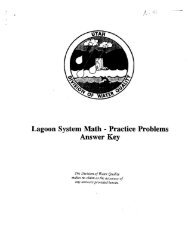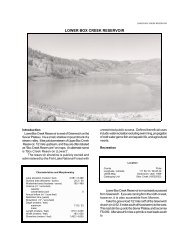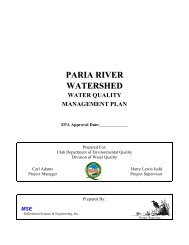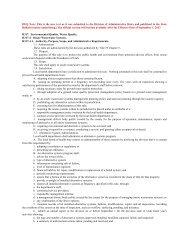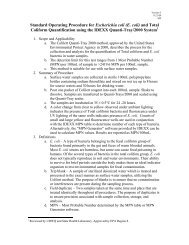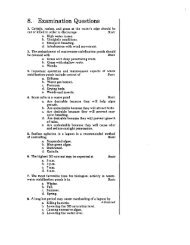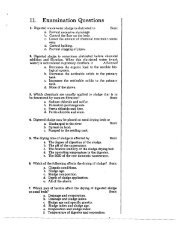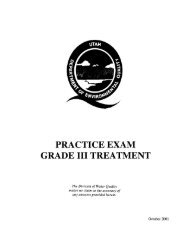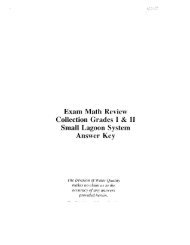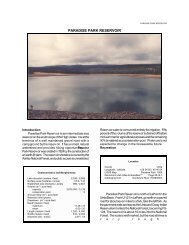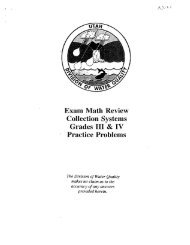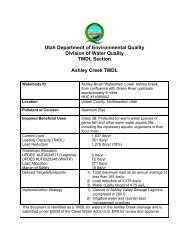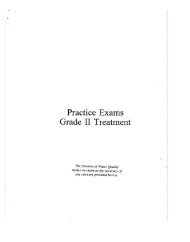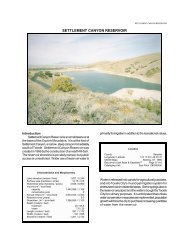Aquifer Recharge, Storage, and Recovery - Southwest Hydrology ...
Aquifer Recharge, Storage, and Recovery - Southwest Hydrology ...
Aquifer Recharge, Storage, and Recovery - Southwest Hydrology ...
- No tags were found...
Create successful ePaper yourself
Turn your PDF publications into a flip-book with our unique Google optimized e-Paper software.
<strong>and</strong> accrues the credits that entitlethe credit holder to recover the storedwater. More than one entity can be astorage partner. Finally, recovery of thewater must be accomplished througha well permitted for that purpose.Benefits <strong>and</strong> Concerns<strong>Storage</strong> at GSFs has the advantage oflower costs. The storing entity usually paysonly a portion of the CAP water costs,with the agricultural user picking up therest. In most cases, there is no facilitycharge associated with storing groundwaterat the site. Contrast this with storageof CAP water at underground storagefacilities (USFs), at which the storingentity pays the entire cost of the water tobe stored in addition to a charge paid foruse of the USF. <strong>Recovery</strong> considerationscan be advantageous at GSFs as well.For an agricultural district, a GSF’s areaof hydrologic impact, where recoverywell permits can be administrativelyeasier to obtain, is the entire district.Concerns about GSFs have mainly centeredon the perpetual groundwater use rightsof agricultural water users in the ActiveManagement Areas. Should affordableCAP water no longer be available, theagricultural entity has the right to returnto groundwater use <strong>and</strong> benefit fromthe higher water levels resulting fromnot having pumped the groundwaterwhile using CAP water. There are alsoquestions about the water managementimplications of recovery outside the areaof hydrologic impact, potentially resultingin recovery at significant distance fromthe storage. (This concern is not unique tothe GSP.) The chart (above right) showsthat much of the GSF storage has beenon behalf of CAWCD <strong>and</strong> the AWBA,with planned recovery occurring in thefuture <strong>and</strong> perhaps outside the area ofhydrologic impact. Because recoveryplans have not yet been developed, thepotential hydrological disconnect betweenstorage <strong>and</strong> recovery is a concern.What is unarguable about the GSP isthat this voluntary water exchangemillion acre feet groundwater stored4.03.53.02.52.01.51.00.50MunicipalArizona Water Banking AuthorityCentral Arizona Water Conservation Districtmechanism benefits the participatingentities while furthering Arizona’s watermanagement objectives. Over 3.5 millionacre-feet of CAP water has been usedin lieu of pumping an equivalentamount of groundwater using this lowcostmechanism. The program enablesmunicipal water providers to utilize CAPwater indirectly <strong>and</strong> inexpensively tocomply with regulatory requirements foruse of renewable supplies. It is a lowcostalternative for the AWBA. Farmersbenefit from water costs below whatthey otherwise would incur, courtesyof their groundwater savings partners.The popularity of the groundwatersavings program is based on the simpleeconomic principle that voluntarytransactions yield mutual gains.For more information, see Artificial <strong>Recharge</strong>, AMulti-Purpose Water Management Tool, Arroyo,Winter 2007 at ag.arizona.edu/azwater/arroyo/.Contact Sharon B. Megdal at smegdal@cals.arizona.edu.1992 1994 1996 1998 2000 2002 2004 2006Cumulative storage in Arizona’s groundwater savings facilities, by type of storer.Innovative Solutions in <strong>Hydrology</strong>2015 N. Forbes Ave. Suite 105Tucson, Arizona 85745Phone: 520.628.9330 • Fax: 520.628.1122www.geosystemsanalysis.comGroundwater<strong>Recharge</strong> StudiesMine Closure <strong>and</strong>Reclamation StudiesWater ResourcesHeap Leach OptimizationVadose Zone MonitoringFlow <strong>and</strong> Transport ModelingHydrologic Testing LaboratoryMay/June 2008 • <strong>Southwest</strong> <strong>Hydrology</strong> • 11



